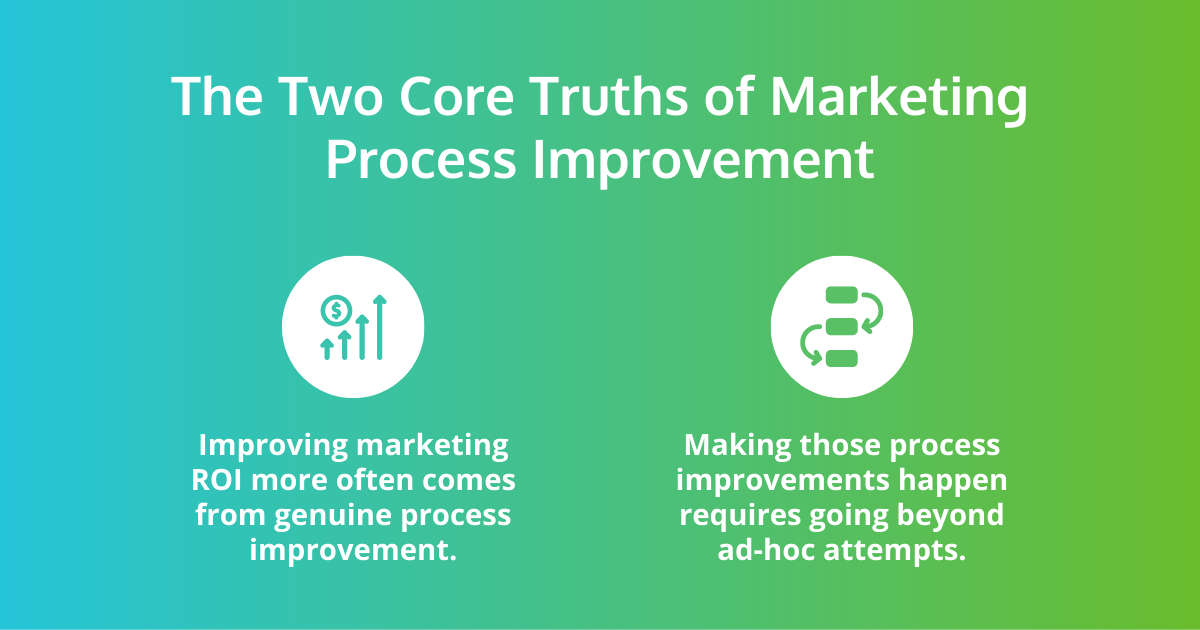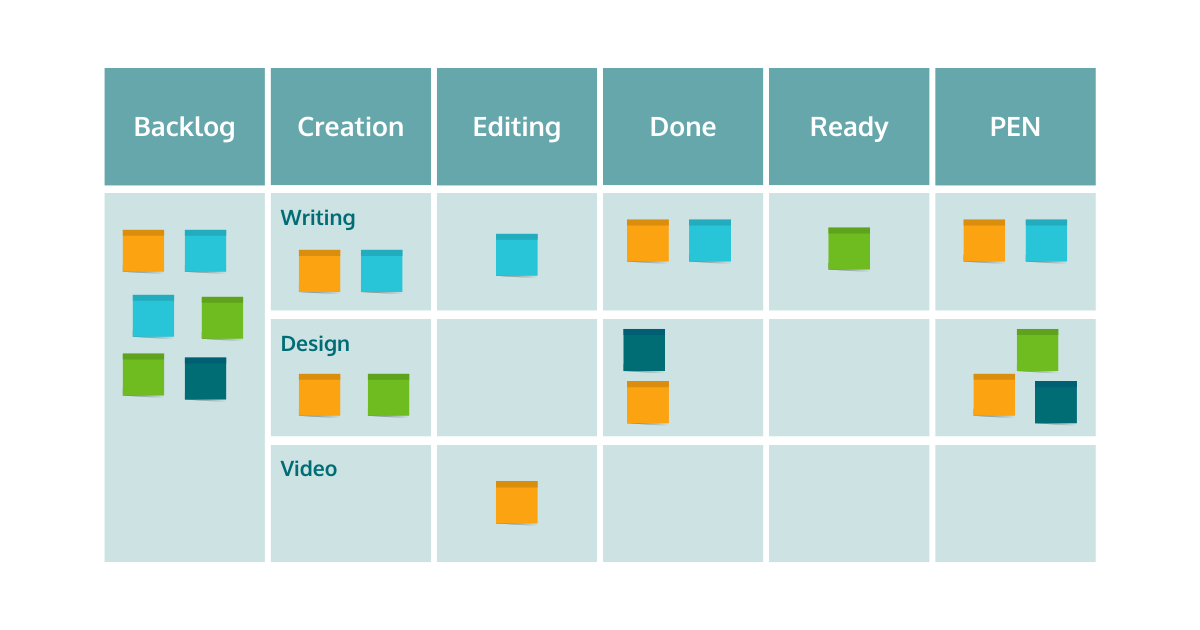Improve your Marketing Ops every week
Subscribe to our blog to get insights sent directly to your inbox.
Confront your process problems head on with a Sherpa by your side.
Explore support options that are tailored to meet you wherever you are on your climb.
Browse our pioneering Agile marketing courses
Learn from the stories of marketers already on the road to process improvement.
Featured Resource

State of Agile Marketing
Learn from 8 years of study on how marketers are increasing their agility.
Download Report
Marketers need to focus more on marketing processes and operations to become and remain effective. Bad processes are incredibly costly and demoralizing. Understanding what marketing processes are and how to improve them is essential for successful marketing.
We humans are so often terrible at seeing the forest for the trees. In marketing, that tendency manifests itself with managers focusing on the quality of the work produced and forgetting to look at the processes involved.
It’s like trying to get from point A to point B by driving in circles for two hours. Instead of trying to just drive faster, you should probably figure out a more efficient route to your destination.
In fact, this tendency often leads to processes bloating as managers decide the solution is something like another round of reviews. The result is bloat disguised as marketing process improvement.
Two true things come to mind:

Done right, all of this can improve your ROI, lower costs, and even make your team members more satisfied. In our experiences these techniques usually result in teams that deliver better quality work faster than before.
Marketing processes are all the structured ways marketers perform various functions. That includes:
All of these marketing processes are important because they are what enable marketers to do their jobs, deliver value to customers, and plan their activities. Their importance comes from the simple fact that marketing can’t function without them.
But really understanding the importance of marketing processes comes from understanding what happens when they go wrong.
Let’s start by really understanding how bad marketing processes affect teams. Appreciating just what a bad process is costing you is the first step toward putting in the work needed to fix it.
Bad marketing processes usually have too many steps. To make matters worse, those steps often create delays that lead to frustration and missed deadlines. For example, you may have someone reviewing completed work who takes a week or more to do so. A single step like this can easily double the amount of time it takes for work to get done and to deliver value, delivering a crippling blow to your team’s ability to perform.
Some teams have the opposite problem, where sloppy work gets pushed through quickly, leading to costly and demoralizing re-work. In these cases, a focus on optimizing the speed of delivery can easily backfire.
This example comes up often because it’s the bane of most marketers’ existence. Reviews can be tremendously helpful, but they can just as easily drive marketers mad and grind processes to a halt.
All of these issues translate into wasted time and money. Using process efficiency measurements like throughput, it’s easy to see how adding additional days and weeks to the time it takes to deliver value quickly adds up. It may not feel like it’s hurting the effectiveness of your marketing process, but even if you just end up with lots of work in progress, that’s damaging your effectiveness.

The way you approach marketing process improvement with Agile will depend on the Agile framework you employ. So let’s begin by running through the main three options to understand how each tackles process improvement.
At its core, Scrum breaks work down into sprints. These can last any amount of time, but two weeks is fairly standard. These sprints begin with a planning session in which the team reviews the work of the previous sprint and decides what to commit to in the next one. Then, once a sprint is over, a retrospective meeting will offer everyone a chance to discuss what can be improved and make concrete suggestions to be tested in the next sprint.
For example, you might find that an email campaign you’re running is performing badly during a sprint. This is brought up in the retrospective, where team members discuss what might be the problem and propose possible solutions. The team decides to test sending three versions of that email to different types of users to see if they perform better. That test is run during the next sprint and the results are discussed in that sprint’s retrospective.
If the performance improves, great! If not, the team can brainstorm more possible solutions to test during the next sprint.
All that is to say, iterative marketing process improvement is built into Scrum. The fact it offers regular meetings specifically designed to discuss and propose those improvements is a major advantage. On the other hand, process improvements that will take longer than one sprint to test may need to be broken up or tested over multiple sprints.
While Scrum breaks work down into Sprints, Kanban is about a continuous workflow. Without work being broken up into sprints, you’ll need to be more proactive about discussing, brainstorming, and testing potential process improvements. This is why it can be useful to schedule occasional retrospective meetings to make sure you don’t forget.
Kanban also relies heavily on the visualization power of the Kanban board. This board makes it far easier to see priorities limit work in progress (more about that in a minute), keep important information easily accessible to everyone who needs it, and empower everyone to just see what’s happening at a glance. All of this helps empower individual marketers to act on their own and deliver more value because it gives them the information they need.
Continuous improvement in Kanban isn’t that dissimilar to Scrum, except the tests you run won’t be limited by the length of your sprints. So it’s up to your team members to identify problems in retrospectives, run experiments, review the results, and implement those learnings without being reminded to do so by the cadence of a sprint.
Our latest State of Agile Marketing Report found that while 25% of marketers use Kanban and another 25% prefer Scrum, 25% actually cherish the hybrid approach. This (shockingly) combines aspects of both Scrum and Kanban to better match the needs of teams who face problems with either framework on their own. Because there’s no single hybrid framework, there’s no single way to approach process improvement. But luckily there are some techniques any Agile marketing team can rely on.
So why are hybrid approaches that popular with marketers? Put simply, Kanban was originally developed for improving manufacturing processes, while Scrum was designed for software development. So it’s hardly surprising that neither is a perfect fit for the unique challenges marketers face. But by combining elements of both, marketers are able to craft something that suits their needs extremely well.
Before exploring some universal process improvement steps you can take, why don't you check is bad processes are eating up your marketing budget?
While each of the three Agile frameworks we just mentioned has their own way to approach process improvements, there are universal steps you can take regardless.
Process waste is work that’s in progress and therefore wasting resources without providing value. Bad processes create this kind of waste by extending the time needed to complete work and deliver value. But identifying that you have process waste is only the beginning.
Often a major hurdle in optimizing a marketing process is understanding where the process could actually use improvement. One step in the process may take a long time but be incredibly important. Alternatively, a step might be so minor that no one notices it doesn’t really add any value.
This is where value stream mapping comes in. By systematically breaking down every step in your processes to determine their costs in terms of time and resources relative to the value they provide, you can really understand how to begin improving that ratio.
While occasionally using value stream mapping is great, simply using a visualization tool is better for spotting problems and opportunities for improvement day-to-day. The most powerful visualization tool out there is the Kanban board. By representing work in cards that move through columns to represent work status, such boards enable you can see where work is getting stuck at a glance.

Limiting Work In Progress (WIP) in any specific column can also help flag where your processes might need improvement. If in-progress work keeps getting stuck in one place, this means you've got a process bottleneck at hand. Bottlenecks are when work piles up in one place because, for example, lots of things need to be reviewed by a person without nearly enough time for all those reviews.
When this happens, you can try to add more capacity (in this example, perhaps hiring another person to help with reviews) or shifting capacity (getting an existing team member to step in to help).
When you try value stream mapping, you’ll likely find that handoffs between teams are one of the most costly steps any marketing process can have. Internal handoffs tend to be better because the people involved probably share a lot of context and can more quickly address the work. People on the same team also share a better understanding of priorities.
External handoffs on the other hand often translate into long draw-out processes requiring lots of reminders and explanations. This is why one common way to improve processes is to build cross-functional teams that keep work internal as much as possible.
The last thing worth mentioning is the vital topic of continuous improvement. Too often organizations throw resources into process improvements only to stop there. But even the most efficient marketing process you’ve ever seen won’t remain so forever. This is why it’s so important to regularly review and find ways to improve those processes.
If you’re using Scrum, this is built-in, but it also may be useful to employ the Plan-Do-Check-Act (PDCA) cycle. Building these steps into your regular marketing process improvement cycle helps ensure you don’t forget to regularly check back in to see whether anything can be improved.
The pharmaceutical company Daiichi Sankyo improved its marketing processes by improving the collaboration between teams and customers. This resulted in campaigns that required far fewer review cycles and were ultimately more relevant. Thus the efficiency and effectiveness of their marketing processes were improved simultaneously.
Tracking Agile metrics like lead time also helped teams understand how other changes they were making were impacting their processes. Issues that weren’t visible from those metrics were raised at retrospective meetings, enabling their marketers to quickly identify and test marketing process improvements.
At Quadient, process improvements weren’t happening. Despite clear indications processes weren’t performing the way they should, they “felt sacred” and marketers were hesitant to make changes.
By building up an Agile mindset amongst teams and implementing processes like Kanban, standups, and WIP limits led to major changes. Kanban in particular enabled teams to visualize their processes and workloads to really understand what was slowing them down.
"The emotional relief is real. Having access to tangible workload data helps reduce the stigma of certain teams being “naysayers” for turning down projects due to heavy behind-the-scenes workloads. And working through planning together helps curb the volume of last-minute requests." - Jayati Shah-Thiel - Sr. Content Program Manager, ICA at Quadient
Despite the regulatory and compliance challenges that come with marketing within the pharmaceutical industry, Charles River managed to make substantial marketing process improvements through Agile.
Their focus was on analyzing key metrics around their processes, visualizing those processes, and ensuring open communication around them. This, alongside regular standups, retrospectives, and backlog refinement, created a major workflow improvement.
How major? They saw their speed to market increase by 50%!
“In just 3 months, we are seeing a significant improvement in project duration, while our project volume is actually increasing across all of our Agile teams." - Darci Helbling - Executive Director, Global Marketing Operations at Charles River
One of the most common barriers to marketing process improvement is team members with long tenures who are used to how things are. They often view changes to processes as unnecessary and counterproductive. Getting over that hurdle at this organization required working with coaches to help convince team members that changes would benefit them.
But it was just as important to enable different teams to find their own way to improve their marketing processes. Each was given access to tools that enabled them to visualize and track the flow of their various processes. By empowering teams to understand their process limitations and develop improvements themselves, hesitations were overcome because people had a sense of ownership.
This example saw an organization whose culture was steeped in the scientific process struggle to accept imperfection as a part of progress. When it came to marketing processes, this struggle manifested itself in long delays while marketers worked to get every detail perfect.
Building an Agile mindset helped these marketers appreciate and find the right balance between speed and quality. They felt comfortable doing that because they had access to quality data telling them they were creating more value more quickly for their stakeholders.
At this healthcare company, one massive marketing process challenge was intake. The marketing function was bombarded with requests from every part of a 13,000-person organization daily. This created chaos, as it became next to impossible to prioritize and manage all of this incoming work. Marketers felt like order takers instead of strategic partners and marketing’s overall capacity and capabilities weren’t used to their fullest. Employees felt undervalued and underappreciated.
To change the situation, teams began tracking metrics like velocity to better understand their capacity and to ensure their outputs were more predictable. They also began using prioritization methods like MoSCoW to understand what work needed to be the focus to produce the most value for stakeholders.
“We went from a completely disengaged team who was frustrated by being order takers, to a more engaged team who was really doing what they do best every day. They were having the opportunity to be empowered and to be the subject matter expert that they were in a particular area to drive forward, ‘the how’ that would ultimately impact our business results,” - The Organization’s CMO
The best metrics to understand how effective your marketing processes are are efficiency, cycle time, and throughput. Together, these metrics enable you to understand how well your processes are performing and identify specific issues like bottlenecks.
Begin with a clear focus on the problem, challenge, or opportunity you want AI to tackle. Then, you can brainstorm ways to implement AI and begin to test them. Using an experimental design or design thinking approach is key because it gives your process structure as you iterate and experiment. But understand that AI isn’t a silver bullet, marketing processes are complex and need continuous improvement, so be creative and dynamic with how you implement AI into them.
Begin by using metrics like cycle time, throughput, and to track your overall marketing process efficiency. From there, you can structure experiments that incorporate AI into your marketing processes and use those metrics to track the results. For example, you might use AI to analyze large quantities of customer questions, reviews, or other information to create quick summaries.
The best tools to improve marketing processes are those that can automatically gather and even analyze your important metrics. Those metrics are the lifeblood of marketing process improvement, but manually compiling them can be time-consuming and lead to more errors. Ideally, you’ll want to find marketing tools that automate as much of this process as possible so you can focus on other things while still utilizing that data to improve your marketing processes.
If you’re seeing a lot of marketing process improvement ideas you’d like to employ but have no idea where to start with Agile, we’ve got the perfect place to start. Our Agile Marketing Fundamentals course has everything you need to build a solid Agile foundation you can use to begin improving your most vital marketing processes.
Subscribe to our blog to get insights sent directly to your inbox.
Subscribe to our blog to get insights sent directly to your inbox.